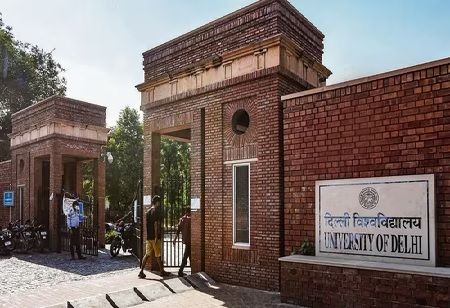- Hindu College tops NIRF 2025, followed by Miranda House, Hans Raj, Kirori Mal, and St Stephen’s among India’s best colleges.
- DU rises to 5th in Universities category, its best-ever performance, while JNU ranks 2nd and Jamia 4th.
- IIT Madras, IISc Bengaluru lead overall, as participation in NIRF grows to 14,163 institutions across 17 categories.
Delhi University (DU) colleges have once again dominated the National Institutional Ranking Framework (NIRF) 2025, with Hindu College emerging as the top-ranked college in the country. It was followed by Miranda House, Hans Raj College, Kirori Mal College, and St Stephen’s College, cementing DU’s stronghold in higher education.
DU also achieved its best-ever performance in the Universities category, climbing to fifth place from last year’s sixth. It further advanced to 12th in Research Institutions while retaining its 15th spot overall.
Calling it a “landmark moment,” DU Vice Chancellor Yogesh Singh credited the achievement to the joint efforts of faculty, students, alumni, and staff. Hindu College Principal Anju Srivastava noted that the recognition highlighted the institution’s emphasis on holistic learning, research, and NEP-driven reforms that encourage flexibility and industry linkages.
Among universities, Jawaharlal Nehru University (JNU) claimed the second spot, with Vice Chancellor Santishree Dhulipudi Pandit underscoring its model of “excellence with equity and innovation with inclusion.” Jamia Millia Islamia (JMI), which was third last year, ranked fourth in the Universities category, while maintaining its 13th overall position and excelling in the new Sustainable Development Goals (SDG) rankings, where it stood third.
Also Read- KOSME Introduces Korea Business Culture Course At JNU For Student Employment In Korean Firms
Vice Chancellor Mazhar Asif said JMI’s strong performance in emerging parameters reflected the dedication of its faculty and students.
The 10th edition of the NIRF rankings was released on Thursday by Union Education Minister Dharmendra Pradhan. Participation has risen significantly from 3,565 institutions in 2016 to 14,163 in 2025 and the framework now spans 17 categories and subject domains, compared to just four in its inaugural edition.
This year, higher education institutions were assessed across nine categories overall, universities, colleges, research institutions, innovation, open universities, state public universities, skill universities, and SDGs along with eight subject domains including engineering, management, pharmacy, law, medical, architecture, dental, and agriculture.
While IIT Madras retained its crown in the overall rankings for the seventh consecutive year, and IISc Bengaluru led among universities, the 2025 list reinforced the dominance of Delhi-based institutions in shaping India’s higher education landscape.

